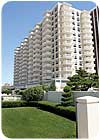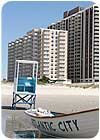

In September 2006, a service call was made to Fire Alarm Maintenance Co. (FAMCO) of Aston, Pa., a suburb of Philadelphia. The call came from the Plaza Condominium, a 14-story high-rise located on Atlantic City’s Boardwalk. The nature of the call? The Plaza’s fire alarm system had failed and required urgent attention.
Upon arriving on site, FAMCO technicians determined that the panel had “self-destructed.” Despite efforts to restore the control panel to normal operation, it was found to be unsalvageable.
“It was an old, outdated system, one that had been out of production for about 15 years,” recalls Ken Scott, president of FAMCO, which had acquired the service and repair contract for the Plaza’s system. “There was no technical support being provided for it anymore, no parts being manufactured. This system was clearly on its way out — permanently.”
It was the original system from the building’s opening in 1965, and although it didn’t seem like a positive event when it happened, the failure turned out to be just that. The Plaza’s staff began to search for a more modern, efficient system to protect the residents of the Plaza’s 158 luxury units.
After contacting the Atlantic City fire marshal and informing him that immediate action would be taken, the Plaza was forced to go into a fire-watch mode. This involved having a guard continually walking through the building on alert for any fire events, and if one were to arise, reporting it to the proper authorities, because any automatic warning capabilities were no longer available.

Claude Damico, the Plaza’s general manager, and the building’s managers, were faced with the daunting task — and expense — of finding a suitable replacement for the system.
The existing system was prone to false alarms because of its age. It consisted of a single, conventional panel board; it was not addressable and therefore was unable to pinpoint the exact location of a fire alarm event.
Although 110-volt horns were located throughout the hallways, no sounding devices were installed in the individual units. Consequently, if a resident were in the shower or listening to loud music, he or she might not hear the horn. Sprinklers were located in each unit, but those played no part in giving residents early warning.
Ultimately, Damico and the Plaza management turned to FAMCO to provide a solution. As long as the new system was effective, easy to use and reasonably priced, they decided that they would trust FAMCO’s recommendation.
Scott proposed a system from Silent Knight, Maple Grove, Minn., a part of the Honeywell Life Safety group and a provider of fire alarm solutions for small and mid-size institutions, as well as commercial sites.

“I’ve been using a variety of Silent Knight products throughout my career,” Scott relates. “I’ve built two central fire stations using their equipment, including digital receivers and transmitters. FAMCO actually became one of Silent Knight’s earliest engineered systems distributors (ESDs), so recommending their system was a relatively easy decision.”
At the heart of the Plaza’s new system is the IFP-1000VIP, an intelligent analog/addressable fire alarm control panel (VIP) combined with an integrated single-channel voice evacuation system. Because the system is addressable, it allows the user to exactly pinpoint the location of a fire event, not simply the floor or zone.
The VIP has built-in support for up to 1,594 addressable devices. Its six onboard Flexput circuits can be configured for auxiliary power, as notification outputs, or for conventional smoke detector inputs (Class A or Class B). The control panel also has a built-in, dual-line digital fire communicator, Form C trouble relay, and two programmable Form C relays.
With all of the critical user interface controls at the main panel, operation and programming of the system is simple. The firmware has features such as detector sensitivity, day/night thresholds, drift compensation, pre-trouble maintenance alert and calibration trouble alert. Three field-programmable user messages are integral to the system’s evacuation capabilities.
The speed of installation was a critical consideration for Damico; he needed to minimize system downtime and ensure that guests were never without protection.
“Like all of the Silent Knight panels, the IFP-1000 can utilize the existing wiring. No special shielded or twisted pair wiring is required,” Scott maintains. “Consequently, we were able to install the panel quickly, replace all the in-unit and hallway smoke detectors with addressable models, and interface the panel with the other existing devices to create a fully operational system in just two weeks.

“The system still needed work, but the Plaza at least had the same level of protection they had before their system broke down,” Scott points out. “Actually, within just two days, we had the panel in, all the audibles working, and a pull station at the front desk.
“Because there is a security guard at the front desk 24/7, he could reach over, activate the pull station and quickly evacuate the whole building in case of a fire event,” Scott notes. “So technically, they had a working, albeit, rudimentary, system within 48 hours.”
Scott says he made his selection of Silent Knight equipment made partly because he knew they would have the panel in stock.
“Generally, the products I need from Silent Knight are readily available,” he maintains. “In this case, that was a must. We just didn’t have time to wait.”
Once this temporary installation was behind them, Scott and his team of technicians undertook the full process in earnest. Near the end of September, his people began rewiring the entire building floor by floor to adapt it to the new system.
This involved connection to the new ancillary devices and compliance with current building and fire codes. These ancillary devices included the addition of speakers in every unit.

Unlike the old hallway horns, these speakers could be heard easily over any ambient noise within a unit, a fact that was established by performing a sound level test in each unit.
Additionally, because the voice evacuation system allows for verbal messages, fire department personnel would be able to pick up the system microphone and provide tenants with specific instructions for what action to take, for example, to exit the building, go to the roof or avoid the stairs.
The Plaza is now connected to a central station, monitored and operated by FAMCO. This station uses the latest technology to provide 24-hour monitoring of the alarm system. Whenever the alarm detects an emergency condition, the FAMCO control station computers receive a coded signal, and all pertinent information is instantly displayed to one of their personnel. Within seconds, FAMCO notifies the Plaza’s staff, the fire department, police and any responding parties.
According to Scott, the job was not without its challenges due to the nature of the facility. “It’s one thing when you’re working at a commercial site,” he declares. “But when you’re working in people’s homes, they are much more particular, and rightly so. We had to make sure we hid all the wiring in each unit, and that we kept the tenant disruption to an absolute minimum.”
Damico was not only impressed with the professionalism of the FAMCO technicians during the installation, but she also was pleased with the assistance FAMCO provided in the transition to this complex system.
“Perhaps the greatest challenge is to reach a comfort level with sophisticated technology,” Damico explains. “Since the present system is state-of-the-art, it requires some instruction regarding its use, which is exactly what the FAMCO people did. Each phase of the installation was explained and demonstrated to management and staff. Plus, instructions were provided to us as to the procedures to follow if an alarm was triggered.”
Thus far, the system is performing up to standards. There have been no fire events to test the system, but there also have been no false alarms. This is notable, given that the previous system was generating one or two false alarms monthly.
The Plaza system installation also has reaped rewards for Scott and FAMCO, because his company was awarded a project in a Philadelphia high-rise and two jobs at Widener University in Chester, Pa., all of which will use IFP-1000 VIP panels.
“This equipment has provided complete coverage for the building, including all the common areas and every unit, thus providing peace of mind, knowing that in a time of emergency, communication can be made throughout the entire building,” Damico testifies.
Ironically, it may not have happened without the failure of an outdated fire protection system.

Sidebar: PROJECTS in the News
When Integration Logistics, LLC, was called upon to design and implement a new video surveillance solution at Cleveland Browns Stadium, their initial concern was to deliver a best-in-breed solution to provide comprehensive coverage of the massive facility and surrounding grounds. To complement the Panasonic video surveillance system specified, John Smolinski, president of Integration Logistics, turned to power supply manufacturer Altronix, Brooklyn, N.Y. To provide comprehensive camera coverage of the facility and surrounding grounds, Integration Logistics’ design called for more than 70 cameras – all of which are powered by Altronix 16-output, high-current indoor power supplies. For maximum efficiency and routing, camera feeds from around the stadium are grouped and centralized to a series of equipment closets. In addition to being the collection hub where video and control signals are transmitted over multimode fiber transceivers that carry signals to and from the stadium’s security command center, the closets also house the power supplies. Altronix UL-listed power supplies deliver 24 VAC power for up to 16 cameras with fuse-protected outputs.